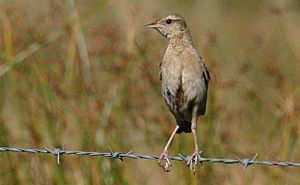Brown songlark facts for kids
Quick facts for kids Brown songlark |
|
|---|---|
 |
|
| male, near Baradine, New South Wales |
|
| Conservation status | |
| Scientific classification | |
| Genus: |
Cincloramphus
|
| Species: |
cruralis
|
| Synonyms | |
|
Megalurus cruralis |
|
The brown songlark (Cincloramphus cruralis), also known as the Australian songlark, is a small passerine bird. You can find it across most of Australia. This bird is part of the Locustellidae family. It's quite special because the males and females are very different in size. This is called sexual size dimorphism, and it's one of the biggest differences seen in any bird!
The brown songlark is a medium-sized bird. It has plain-looking feathers. Females are brownish on top and lighter underneath. The males are larger and a darker brown color.
Contents
What's in a Name? (Taxonomy)
The brown songlark was first described in 1827 by two scientists, Nicholas Aylward Vigors and Thomas Horsfield. They called it Megalurus cruralis. Later, in 1843, another scientist named John Gould placed it in the genus Cincloramphus.
The name Cincloramphus comes from ancient Greek words. Cinclus means "wagtail" and ramphos means "beak". The word cruralis comes from Latin and means "leg" or "shin".
What Does It Look Like? (Description)
Male brown songlarks are quite a bit bigger than females. Males are usually 23–25 cm long, while females are 18–19 cm. A male can even weigh more than twice as much as a female!
Generally, these birds have dull, pale feathers with darker brown streaks. They also have pale eyebrows. The feathers on their belly are brownish-white for females and a darker brown for males. During the breeding season, males might show a reddish-brown color. Their eyes and beak are black, and their legs are grey. Young brown songlarks are smaller and paler. They have pinkish-brown beaks.
The male brown songlark is the main singer. Its call is loud and sounds a bit creaky. You can often hear males singing from high places or while flying above their breeding areas.
Where Does It Live? (Distribution and Habitat)
You can find the brown songlark almost everywhere in Australia. The only places it doesn't live are parts of the far north and Tasmania. There are many of these birds in the southern parts of the country.
This bird loves open areas like grassy fields and scrubland. It finds its food there, eating seeds and insects. The brown songlark is a "nomadic" bird, which means it moves around a lot. The number of birds in a certain area can change depending on how much rain there has been. They will often leave places that are suffering from drought.
The brown songlark lives across a very large area, covering millions of square kilometers. Even though we don't know the exact number of birds, they are reported to be common. Because of this, the IUCN says the brown songlark is a species of "least concern". This means it's not currently at risk of disappearing. Australian authorities also consider it "secure".
How Do They Have Babies? (Reproduction)
Brown songlarks usually build their nests between August and December. Their nest is shaped like a deep cup. They make it from plant materials and hide it well in bushes or tall grass.
Most pairs have one group of eggs, called a "clutch," per breeding season. A clutch usually has 2 to 5 eggs. These eggs are pale pink with reddish-brown spots and flecks. Each egg is about 23 mm long and 17 mm wide. The female bird does most of the parenting. Unfortunately, animals like foxes and snakes sometimes try to eat the eggs or baby birds from the nests.
See also
 In Spanish: Yerbera parda para niños
In Spanish: Yerbera parda para niños


